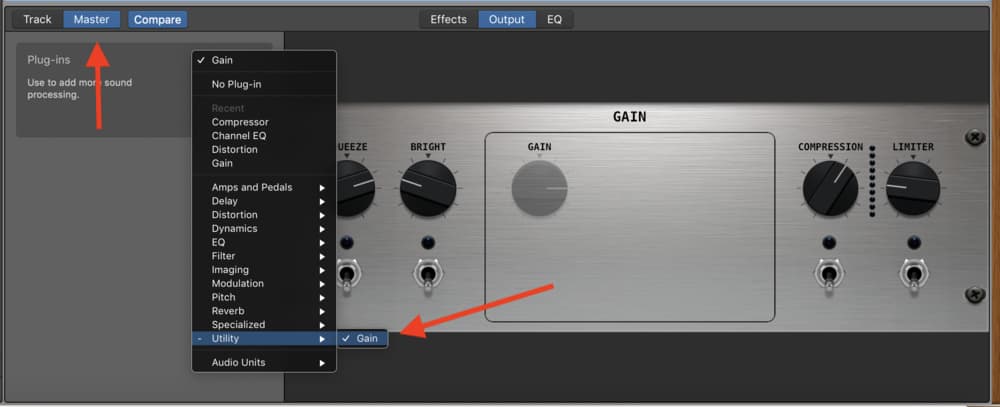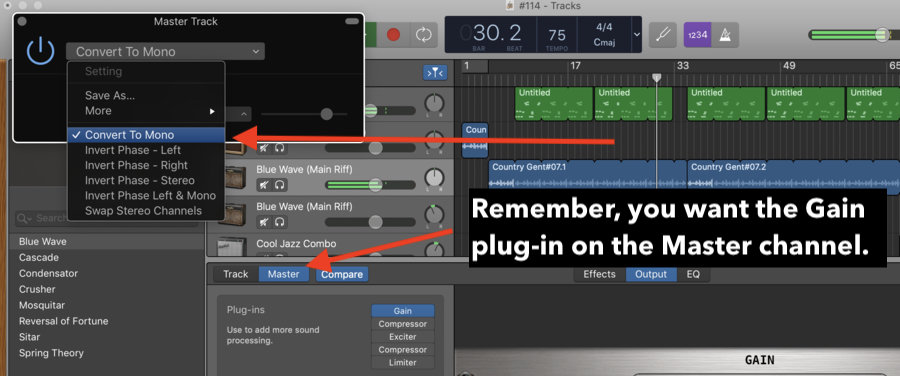Other than familiarizing yourself with the keyboard and music theory via PianoForAll, one of the simplest ways, mixing in mono is one of the most popular and frequently suggested tips out there for music producers, mostly because of the way it highlights the way the track sounds in a single channel.
However, you may wonder how to actually get your tracks in Mono in GarageBand.
It’s really quite simple.
In short, this is how you do it.
How To Convert Your Tracks To Mono
1) Open Master Track
2) Go into the “Utility” plug-ins of the Master Channel
3) Select the “Gain” plug-in
4) Go into the “Gain” plug-in’s drop-down menu, and then select “Concert to Mono”
5) Hit the On button, and voila! Your master channel is now in Mono
Here is the more in-depth tutorial for how to the above steps along with helpful images to guide you in the process.
1) With Garageband open, go into the Toolbar within the “Track” option, and then click on the option, “Show Master Track.”

You can also use the command, (Shift + Command + M)
2) Next, you want to go into your plug-ins of the Master channel. This is key. Go into the Plug-ins of the “Master” channel, and not the “Track” channel.
3) Select the plug-in, “Utility.”

4) Select the plug-in “Gain,” within the “Utility” plug-ins.
5) Go into the Drop-Down menu of the “Gain” plug-in, and you’ll notice the function that says, “Convert to Mono.” Click on it, and voila! You can now listen to the track to see how it sounds in mono.

If you’re currently researching all the available information on this topic, whether on the internet or in a good old-fashioned book, you’ll notice that this practice is recommended often.
So, why is it a good idea to mix in Mono?
After doing some research and spending my time with this technique, I think I can answer that question for you.
Why You Should Mix in Mono
1) It Highlights Imperfections In The Mix
Frankly, I’m new to mixing in Mono as well, however, in my application of this brand new tool, I managed to learn a lot about mixing and how, we, as producers or whatever we call ourselves, can best utilize the tools at our disposal to make the best sounding mixes possible.
In short, you’ll find that if you mix a track in mono, when you switch it back over to Stereo, it’ll sound a whole lot better.
Simply put, mixing in mono, from what I understand, means that we’re listening to the mix in one channel, whereas, in stereo, we’re listening to it in more than one channel; two, panned left and right.
In other words, putting the mix in one single channel highlights little imperfections in the way that the frequencies, or the sounds, are portraying themselves together.
For instance, mixing in mono allows us to see the way that there may be too much low-end in a mix, and we didn’t really realize it at the time.
When mixing in stereo, the tracks are panned to the left and right, so the frequencies are spread out evenly between the two channels.
However, after we’ve switched the channel to mono, it brings all of the sounds to the middle, and suddenly, the imperfections or concentration of certain frequencies is suddenly more apparent than they were before.
So, after you’ve selected the Master Channel to Mono using the Gain plug-in, you can do all of the mixing, including the EQ, panning, compression, and so on and so forth.
Once you switch it back to Stereo, you’ll notice that everything just sounds a lot better.
2) Makes the Mix Sound Better Across Different Sound Systems
Another reason to mix in mono is that it protects the mix from sounding terrible once we translate it to another speaker system.
For instance, a mix may sound great when we listen back on our monitors, whether they are high-quality headphones like Beyerdynamic DT 990 Pros on my Product Page (which are my favorite), or actual speakers, but when we listen to it on our iPhone headphones, it doesn’t sound as great.
Mono mixing allows us to protect ourselves from this mishap.
It pushes our music to the center of one channel and illuminates any issues with our mix that would’ve been harder to see otherwise.
If your track doesn’t sound good in mono, or you haven’t listened to it in mono yet, you probably don’t have an idea of what it really sounds like yet.
Get used to mixing your tracks in mono, so much to the point that you don’t even remember that you’re not in stereo. You’ll find when you switch back to stereo, the sound will improve.
Another good thing about this tactic is that creates a better mix for real-life situations.
For instance, if you peruse the beat-making side of Instagram, you’ll notice a lot of producers and beginner artists will suggest listening to their beats using good headphones.
The reason why is because, in their mind, the track sounds a lot better with a good sound system, and it does, but frankly, this isn’t a realistic thing to ask of the general public.
It’s almost as if they’re asking you to do them the favor of listening with good headphones that way you don’t discover how crappy the mix sounds through their laptop/cell phone speakers.
Most people are going to be listening to your music in their car, on their iPhone 11 Pro Max (also on my Product Page), or in a loud club, and they’ll be standing closer to certain speakers and not others.
If you’re asking your fans to listen to your songs only using good headphones, then that means there is something wrong with the mix.
The mix should sound reasonably well, or at least, with all of the instruments cutting through, that way people can actually hear all of the instruments.
Explained in another way, our music should sound as balanced as possible regardless of the sound system we’re listening to.
Most people will listen to our music with sub-optimal headphones, and in environments where there are other noises. As I’ve explained in my guide on how to mix, a good mix is optimized for every type of sound system and every environment.
3) Helps Solve Panning Issues
Also, I find that mono-mixing helps to illuminate issues and mistakes made in the panning of the track.
If you can pan all of your tracks correctly – using my guide as a frame of reference – and you make them sound awesome in Mono, when you switch it over to Stereo, the song will likely sound great.
From what I understand about music, many of the platforms still used today play their music in mono, for instance, on television, radio, as well as in large venues.
Apparently, it’s nearly impossible to get a stereo-sound in a large venue on account of the place being so big, and setting up speaker systems to emulate a stereo system would be expensive.
Some producers, especially those who DJ, have stories of making a mix with vocals in it, and because they never checked it in mono, they find that when they take that very same track and play it in a large club, suddenly the vocals have disappeared.
According to the book Mixing Audio, from Roey Izhaki (get it here from Amazon), some albums actually have issues when summed to mono, for instance, Nirvana’s Nevermind, particularly, “Smells Like Teen Spirit.”
When listening on a mono system, such as the radio, the higher frequencies in “Smells Like Teen Spirit” are harder to hear.
Moreover, some studios apparently have single speaker systems set up in one part of the studio, that way engineers can listen back to their work in mono and have a better grasp of what their music sounds like in different systems.
Roey writes in his book that switching back between mono and stereo helps with understanding the “authenticity” of the panning and other features of the mix.
Phase Cancellation And How Mono Mixing Fixes This Issue
Another thing that I learned about when researching this topic is what’s called “Phase Cancellation.” This is a phenomenon in which certain frequencies vanish and are suddenly unheard.
Phase refers to sound waves, which are the vibrations in the air that make noise/music.
Apparently, if two signals are similar to each other and are played back at the same time, they literally cancel each other out and we’re unable to hear them.
This is why, as I noted above, some people will mix a recording and when they play it in a large venue, the vocals or another sound frequency will simply vanish into thin air.
During the recording process, if there are more microphones, there is an increased probability for phase cancellation, with the biggest culprit being the drum kit, because of all the different microphones hooked up to the kit.
Moreover, there are some situations when even speakers aren’t wired properly so there will be some phase cancellation.
However, for most people who are just getting into music production, I believe that worrying about audio engineering concepts and practices such as these ones are beyond what’s necessary.
It’s just something to consider, and it’s also another reason why mixing in mono is a useful tool for ensuring that we’re really doing a good job on our mixes.
In the YouTube video tutorial below, I show you how to turn on the Mono feature using the Gain plug-in on the Master Channel.
YouTube Video Tutorial
Conclusion
I would say that mixing in Mono is one of the better ways to push your songs to a more professional sound.
Truthfully, I can’t tell you that I’m an expert at getting professional sounding music, however, I can tell you that mixing in mono is a step in the right direction. At least it has been for me.
That’s all for today. I hope you found this article and YouTube video tutorial helpful.


 Written By :
Written By : 